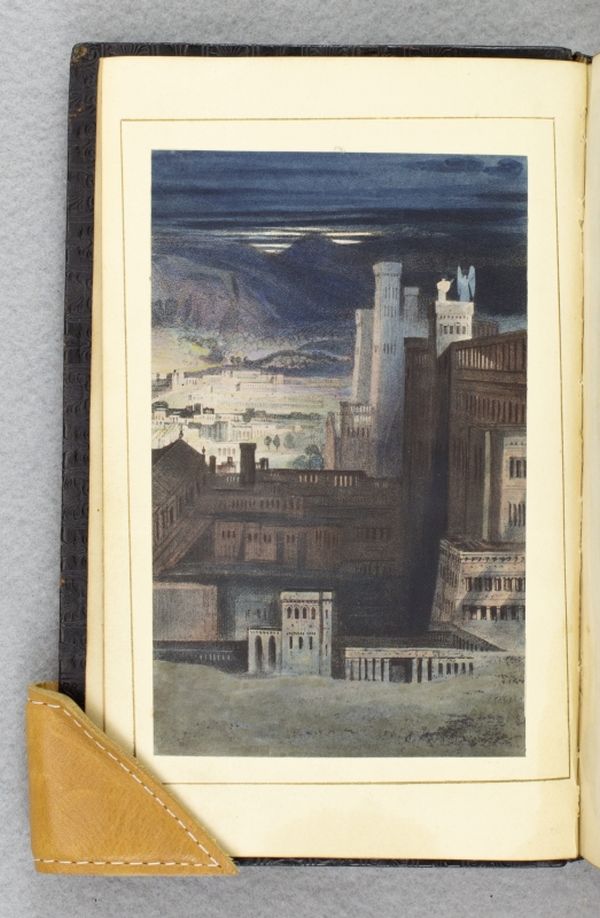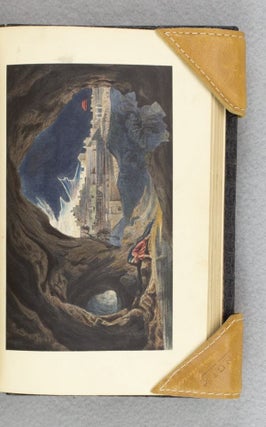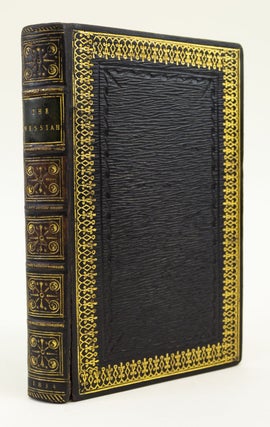THE SACRED ANNUAL: BEING THE MESSIAH, A POEM.
(London: John Turrill, 1834). 191 x 121 mm. (7 1/2 x 4 3/4"). xi, [i] pp., [2] leaves, 300 pp. Fourth Edition.
Appealing 19th century black straight-grain morocco, covers with a gilt filigree and blind-rolled frame, raised bands, spine compartments gilt with curling cornerpieces and lancet tools radiating from a central circle, black morocco label, blind-rolled turn-ins, marbled endpapers, all edges gilt. With extra chromolithographed "missal" title page, woodcut tailpiece by John Franklin, and 10 COLOR LITHOGRAPHS mounted on heavy stock, three of these by John Martin (The Temptation, The Sermon on the Mount, and The Remorse of Judas), all lithographs with captioned tissue guards. Front pastedown with armorial bookplate bearing the motto "Soli Possumus Facere Nihil," front free endpaper with animated engraved bookplate of George Oliver Clark, with the added inscription "To 'Nona' and Michele with 'Didi's' love - Jan. 21, 1948." ◆Joints a little rubbed (part of the front joint with thin crack), spine gilt a little muted, corners very slightly worn, but the binding without any serious condition issues and definitely pleasing. Isolated faint spots internally, but the text and plates generally very clean and fresh.
This verse retelling of the life of Christ is enhanced with very attractive color lithographs by leading illustrators and presented in a pleasing, appropriately somber binding. Foremost among the illustrators represented is John Martin (1789-1854), who began his career modestly as a provincial painter of coats of arms on the coaches of the nobility and ended up being one of the most popular English artists of the 19th century. He studied under the Italian artist Bonifacio Musso and moved to London with his master in 1806. He first exhibited a painting at the Royal Academy in 1812 (selling it for 50 guineas), and this was followed by a series of other exhibited works, most of them huge canvases showing classical or biblical themes, some of which carried off substantial monetary prizes. Of particular note was his painting of "Belshazzar's Feast," for which he was awarded £200 in 1821. His illustrations for the present work stand out from the other plates by their scope and grandeur: while most of the other artists chose to portray more intimate scenes, the figures in Martin's works are quite small, surrounded by imposing mountains, towers, and sweeping clouds. Humanity is dwarfed by the awe-inspiring divine. In addition to being a painter, Martin was a major mezzotint engraver, and it was as an engraver that he became immensely popular with the public (it was also as an engraver that he earned the largest share of his income). His mezzotint illustrations for American publisher Septimus Prowett's edition of Milton's "Paradise Lost" are perhaps his best, and certainly his best-known, works. The author of the present book, Robert Montgomery (1807-55), was a great admirer of Martin, lauding him as "a second Milton," and he was no doubt extremely pleased to have his work illustrated by such an artist. Montgomery rose from very humble beginnings to become a clergyman in the Church of England and a bestselling author of devotional texts. Although incurring the contempt of critics--one describing the author as "a byword for all that is vacant, vague, and inane"--Montgomery produced religious epics that found an enthusiastic readership among what DNB calls "a large and relatively new class of readers whose tastes and expectations were very different from those of the cultural élite." This work shows up in the marketplace occasionally, but it is almost always found in a restored binding and/or in unpleasant condition. (ST12776b)
Price: $1,500.00



